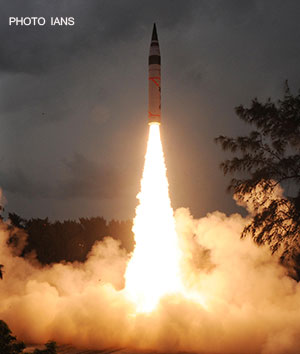
The fourth test launch of the nuclear capable Agni V missile was completed today from Abdul Kalam Island (formerly Wheeler Island), off the coast of Odisha. The indigenously developed Inter -Continental Ballistic Missile (ICBM) is now ready for going through user trial and for being commissioned into the Strategic Forces Command (SFC).
Pitched as the most potent missile of India the canistered test-firing of Agni V took place at 11:05 IST by Defence Research Development Organisation (DRDO) in Complex-4 of the Integrated Test Range (ITR). As reported by a DRDO official, the process was executed in an unflawed and impressive manner as the missile ascended from within its canister and accomplished all the targets which were required before diving into the Australian waters.
With a range of over 5000 km, the solid propeller weapon is capable of striking even the northernmost tip of China. A three stage solid-fuelled missile, around 17.5 metres in height and with 50 tonnes of launch mass, it has composite motor casing in the second and third stage. The missile uses many advanced technologies like Inertial Navigation System based on Ring Laser Gyroscope and Micro Navigation System for guidance and navigation with impeccable accuracy. Reportedly, the impeccable weapon also features Multiple Independently targetable Re-entry Vehicle (MIRV) for greater efficiency. Having a MIRV payload would mean that Agni V can carry multiple warheads (2-10) with each nuclear warhead allocated for distinct targets.
Equipped with accelerometer, the ammunition is programmed to get propelled at a very high and increased speed towards a set target, after reaching the apex of its trajectory and turning towards earth. This happens due to the earth's gravitational pull combined with the Inertial Navigation System, advanced on-board computer embedded in the missile for precision. It is designed and developed in such a way that it would ensure second strikes in with pure credibility, even with the availability of few missiles. Its easy road mobility characteristic makes it more conveniently destructive.
The defence experts believe that this outstanding ammo will prove more than just sufficient to deal with the ongoing speculated threat and to deal with major security concerns. After the Induction of the Agni V missile in SFC, India will be included in the elite and exclusive ICBMs' club, which consists of Russia, US, UK, China and France. The induction of Agni I, Agni II, Agni III along with short-ranged Prithvi and Dhanush Missiles in the armoury SFC have taken place in the past.
Agni V had its two earlier flights in 2012 and 2013 but in open-configuration and despite having being proved of its strength, it was again test-fired through a mobile-launcher integrated with canister in 2015 and now in 2016. The second version of missile launch enables assaulting with lesser preparation in lesser time and with greater accuracy.
Prime Minister Narendra Modi congratulated the DRDO on its extraordinary achievement and commented, “Successful test firing of Agni-5 makes every Indian very proud. It will add tremendous strength to our strategic defence”.
|
|


Comments: